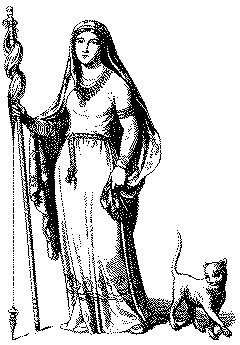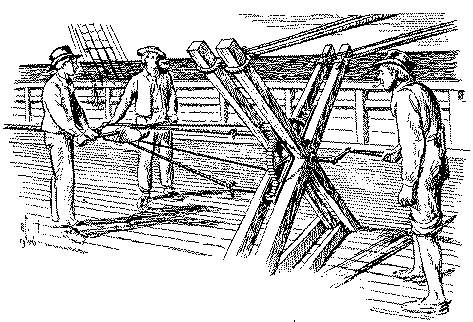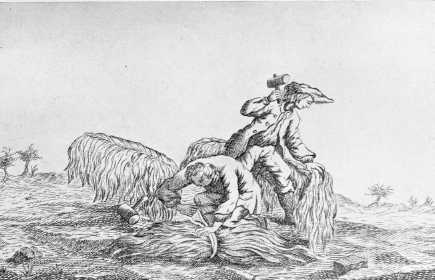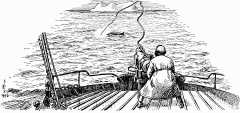This article was previously published in The Journal of Industrial Hemp published by the International Hemp Association
In the Norwegian valley of Gausdal, people in the nineteenth century would lift their hats in greeting as they approached a field of hemp. The plant was known to house a vette, a nature spirit best treated with respect.
In Norwegian folklore hemp cloth symbolized the beginning and end, and it was the first as well as the last in which people were swathed in in this life. These traditions may be relics from a time when hemp had a religious function in the pre-Christian religion, but the central use of hemp in Norway for the last thousand years has been as a source of fibre.
Hemp may have been grown in Norway in pre-historic times. Pollen samples suggest hemp growing in the vicinity of the Oslo fjord in the Roman Iron Age, around the beginning of the Christian era.
All this is, however, uncertain. The first certain proof of hemp in Norway is from the Viking age. Woven textiles of hemp were placed in graves in Southwestern Norway around the year 1000. They were probably fragments of sail. Otherwise the usual material for Viking ship sails was wool or nettle fibre.
Hemp fibre was most important to the Vikings as material for cordage. Until hemp came into use, ropes and lines were mainly produced from the bast of lime trees. The long, supple hemp fibres made it possible to produce better cordage, which in turn was an important precondition for the long sea journeys of the Vikings. Hemp was, therefore, an important item of trade as well as an important bounty from their regular armed raids.
The well respected archeologist, Anne Stine Ingstad, who was responsible for excavating the medieval Norse settlements in Newfoundland, is prominent among many historians who believe the younger of the two buried women -usually called the Oseberg Queen - was a priestess of the great Norse goddess Freya, and not only a secular queen as the first excavators thought. Ingstad sees the presence of the Cannabis seed in the (talismanic) pouch as an indication of possible ritual use of cannabis as an intoxicant in pre-christian Scandinavia.
The find of hemp seeds in the Oseberg ship may be interpreted in various ways. Without a doubt the presence of these seeds proves that the hemp plant had reached Norway by the early Viking days, but we do not know whether the seeds were grown in Norway, or how they arrived in the country. We also do not know how the hemp, once cultivated, was utilized.

In the ninth century there were active trade routes both eastwards through Russia and westwards along the European coasts and waterways. It is also reasonable to suppose a cultural connection to Cannabis seeds that were placed in tombs in central Europe more than a thousand years previously.
Worth noting in connection with the Oseberg find is the lack of ropes and textiles made from hemp. This is one reason for suggesting a ritual use for the Cannabis seeds. The women in the Oseberg ship had clothes made from flax, wool, silk and nettle, but not from hemp. The ropes were made from lime fibres in spite of the better quality of hemp rope.
IngstadÔs suggestion that Asiatic ritual use of hemp may have reached Scandinavia corresponds well with the origin of hemp in central Asia and with etymological theories tracing the word cannabis to finnish-ugric roots. The existence of female noaides (saami shamans) has been established by May-Lisbeth Myrhaug, but ritual use of hemp seems to be unknown in saami noaide tradition.
In addition to the theory of ritual use of hemp in Viking times or earlier, it is prudent to consider another, more mundane, theory: the hemp seeds were placed in the pouch of the Oseberg Queen for their rarity. These were highly prized seeds of an exceedingly useful plant, as yet rare in the north. The hemp seeds were valuable for their promise of better cordage and more durable textiles. Such a theory does not, of course, exclude the possibility that hemp may also have had ritual uses.
In Norway, hemp fibre has mainly been the raw material for ropes and rough textiles. If hemp might have supplied textiles as fine as flax, it has, at least with fibres grown in Norway, required more work. Flax has usually been finer than hemp, but Italian hemp varieties could provide a quality comparable to linen textiles. As recently as in 1977, Olav Skarsvaag, a fisherman from the island of Frøya, recalled his family tradition:
Until the end of the last century lines and nets were made from hemp. Cotton came into use around the turn of the century. I guess the cotton was not asstrong as the hemp, but it was a little cheaper. ... The hemp mostly came from Russia and Italy, and I believe the Italian was considered finer and smoother than the Russian. Until around 1880 it was usual to spin hemp-yarn in the household.
In "The King's Mirror", an instruction book from the thirteenth century, written for an unknown noble youth, the young man is advised to cover his shirt with a (woolen) cloak before approaching the king, since "no man can make himself attractive in linen or hemp". (Hellevik 1965) It would seem that hemp was regularly used closest to the body, as underwear. However hemp has also been used for finer textiles, and occasionally even for decorative weavings. Examples of these may be seen at the Nordenfjeldske Kunstindustrimuseum in Trondheim
In more recent times, most Norwegian farms of any size have had their own hempfield, often in the vicinity of the dung cellar. There are reports of hemp cultivation as far north as Velfjord in the county of Nordland. In the central parts of southern Norway hemp was used as a textile fibre, but along the coast, the hempen fibres were utilised for all manner of lines, ropes, nets etc. in the boats and ships. It seems the more beneficent climate in the inland valleys was better suited for hemp cultivation than the stormy coastal districts, and therefore more hemp was grown inland than along the coast were the biggest demand was.
There are also a few reports that hemp has been utilized in popular medicine, against snakebite, mostly, but also for "heatedness of heart" and for eye problems.
In a Norwegian dictionary from the late nineteenth century we learn that hampebraak or hampedengje signifies a "noisy or slothful woman". Of talkative people it might be said that "the mouth went like a hampeklove." These words refer to well known tools from the various stages in the preparation of hemp fibres. Much has been the same as for the preparation of flax fibres, but the hemp tools were rougher than the corresponding tools for flax.
Traditionally the male plants have been harvested first, the females a little later. The plants were pulled up with the roots and dried in bundles. The seeds could then be shaken off before the plants were soaked in water for retting. When the soft parts of the plant have been dissolved, the stalks are dried once more and pulled bit by bit through the hampebraak. This has a "mouth" that breaks the stalks, and makes it possible to remove the fibres from the wooden parts. This is heavy work that was usually done by the menfolk.
The next step is pulling the fibres through the hackle, a kind of comb that separates the fibres. This was considered lighter work and was done by the women. The hackled fibres could be spun and then woven, or used for making cordage.
Those who bought imported fibres in "dolls", bundles of fibres weighing 6-9 kg., avoided much of this preparatory work. The hempdolls were used for ropemaking and other purposes on the farms in wintertime, as reported by Mr. Skarsvaag.

On the Danish island of Fyn, tradition holds that the art of growing hemp was brought back by sailors from the Baltic lands.(Br¿ndegaard 1979) In the Danish parts of the realm the conditions for growing hemp were much better than in Norway, and King Christian IV, in 1629, demanded of the Danish farmers that they grow hemp to supply his navy. He supplied seeds through his sheriffs. His successor, Christian V, even included the duty of growing hemp in his Danish Law of 1683, which states:
Every farmer who holds a full farm, and does not sow a bushel of hemp seed, and he, who holds half a farm, half a bushel, should by his lord be charged and punished as an obstinate and reluctant servant, unless he proves that he has no suitable soil therefore.
In the corresponding Norwegian law the passage on hemp cultivation was not included, but we must suppose that the king's officials tried to stimulate hemp-production in those parts of Norway where this was possible. The growing import of hemp fibres must have been cause for worry. To the port of Bergen alone, the amount imported during the period 1650-1654 was 3064 ship pounds of hemp (approximately 500 tons), mainly from the Baltic countries. The regularity of the Baltic trade in hemp and linen is also testified in two lines from a well known poem written by the priest and poet Petter Dass in 1702:
To Revel and Riga your Voyage did go Your Hemp and your Flax to acquire.
It was quite common for hemp and flax to be mentioned in the same context, and it is not easy to distinguish between materials made from these two types of fibre.
The Dane Gerhard Schning traveled on behalf of the Danish king through parts of Norway in 1773-75. His report to the king is an important source of information on this era. Describing the state of industry and agriculture in the towns and in the countryside, he complains that too little hemp is grown in most villages, although some hemp is grown even in mountain villages like Oppdal. All the more pleased did he become when approaching the village of Sparbu:
As soon as I entered Sparboen, I immediately encountered a large field of hemp. There was little or nothing to see of hemp in the previous villages in Indherredet, in Sparboen however a great deal thereof. (Schning 1979, II, 75)
Some places, like in "Surendalen" much hemp was grown. "The crops of hemp and flax are many places buxom" B.H. Loevenskiold reports from Bratsberg, near Trondheim, in 1784. But local production has evidently not been sufficient to to cover demand, since farmers from Jmtland, across the Swedish border, every year made the trip into Norwegian markets with hemp as well as flax.
The authorities constantly sought to stimulate further production of hemp. In 1775 the Royal College of Sciences in Trondheim offered a prize for the best treatise on hemp cultivation, and the winner was a parish priest, Claus Finde, from the west coast district of Sogn. His winning essay was never published, but the manuscript is kept at the library of the Royal College of Sciences in Trondheim. Father Finde describes the various kinds of soil that are suitable for hemp and flax, the procedures for sowing and reaping, including the method of separating the male plants (Giaedder) from the females.
The newspapers also did their bit for the cause of hemp. Adresseavisen in Trondheim, in 1802 published an article on the cultivation of hemp, including the following passages:

A sensible farmer cultivates for himself as much hemp as is needed for the running of his farm. ... At the beginning of May, after the conditions of the year, the hemp should be sown, when the soil is dry, harrowed down with a wooden harrow and rolled. Thereafter small creatures such as chickens should be kept well away from it. ... Once the hemp is sown and treated as shown, it will grow so that it in the month of August has progressed far enough that some of it is ripe, and can be pulled ... The Male hemp ripens first and it is this that first must be pulled, or rather separated from the female. One starts therewith from one edge of the field, takes out or pulls up the ripe hemp in one's front, in this way one obtains space to enter the hemp without damaging the plants that remain standing. The female hemp, the one that bears the seed, should yet remain standing 3 to 4 weeks to ripen. (Adresseavisen 1802, nr 14)
During the Napeolonic wars the ports of Denmark and southern Norway were blockaded by the English navy. No cargo could enter the country from the Baltic. Merchants from Trondheim and Bergen therefore sent ships northwards to the Russian port of Arkhangelsk to fetch cereals, hemp and other goods, but this was not sufficient for the needs of the country. When Norwegian privateers, in the year 1809, captured a British ship loaded with hemp, and brought it into the port of Trondheim, the government wanted to secure this valuable cargo for state needs. The privateer captains refused to bow to this demand, since "the country is in the greatest need of hemp for the fisheries and merchant navy purposes". They managed to sell 1500 voger of hemp, (around 27 tons) before the government could secure the remaining cargo.
Against this background it was only natural that the Royal Society for the Welfare of Norway, which was founded in 1809, agitated strongly for increased cultivation of hemp in Norway. Sheriff Sivert Aaarflot from Volda in 1805 published a small book in Copenhagen on "The cultivation and preparation of hemp". He also disseminated information about hemp cultivation through his own magazine "Norsk Landboeblad".
The Danish-Norwegian kings took steps to organize and tax the ropemaking industry from the seventeenth century. In 1607, a "new rope walk" was established in Bergen, at that time the main Norwegian harbour, implying that one or more such institutions had been in existence previously. In Trondheim, two local merchants were given the royal privilege of producing rope in the year 1637.
The production of rope was a handicraft requiring a building or an open space the same length as the rope to be made, since it was only in the twentieth century that machinery was developed allowing cordage to be coiled during production. If the rope walk had no roof, ship's cordage could only be made in dry weather. It was illegal to sell cordage made from wet hemp as naval equipment.
To make the hempen ropes strong and supple they had to be impregnated with tar. The tar was heated in large receptacles through which the rope could be pulled or dipped. A rope walk was therefore a fire hazard, and was for this reason often placed outside the town centre.
The necessary amount of hemp fibre was huge. One single sailing ship needed several miles of various types of cordage. The pinnacle of Norwegian naval rope making was the anchor cable for the frigate Kong Sverre, made from 4 tons of russian hemp. It was carried through the streets of T¿nsberg, in the year 1864, by 120 sailors led by a marching band.
In the years 1870-1874, Norway imported more than 18 000 tons of hemp and 1200 tons of cordage. In times of war and crisis, trade was often interrupted, and the rope walks therefore needed large stocks of hemp fibre. One large ropewalk, T¿nsberg Reperbane, had storage capacity for 2000 tons of hemp. During World War I, Norwegian merchants were forced to reopen the old Northern sea route to Arkhangelsk, and in 1918, a cargo of 900 tons of hemp arrived in the Northeastern town of Vard¿, where the local authorities did not have enough storeroom. Parts of the cargo therefore had to be stored at Hammerfest, further west.
After World War I, the demand for hempen cordage dwindled swiftly. The amount imported in the period 1920-24 was only half of the amount a decade earlier. However in the late 1930s an increase was caused by the upsurge in Antarctic whaling. The whalers were fussy about their equipment, and the harpooners were especially careful about the "forerunner", a slender rope connected directly to the harpoon. Only hand spun Italian hemp had the desired quality.

In the period 1930-35, the importation reached a new high level of almost 20 000 tons of hemp, while the export of cordage reached more than 3000 tons.
During the 1990s, hemp cultivation was reintroduced in several northern European countries, but a side-effect of the hardline drug policies in Norway and Sweden was that all applications to grow hemp, from scientific institutions as well as individual farmers, were turned down.
In the summer of 2001, however, a public controversy arose when a small number of farmers in the county of Vestfold turned over 3000 illegally cultivated low-THC hemp plants to the police, and demanded to be prosecuted. The Minister of Agriculture immediately promised to look into the restrictions on industrial hemp, and a few weeks later his Ministry delivered a report on the problems of separating intoxicating from industrial hemp strains. The ministry did not foresee any large problems in this regard, and recommended a system of licensed growing. At this writing, however, (December 2003) it is uncertain whether these recommendations will be put into practice by the new centre-right government.